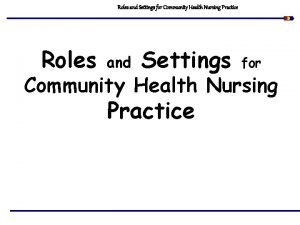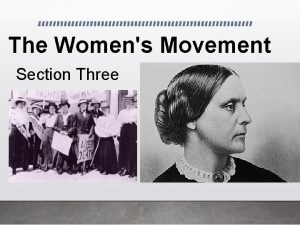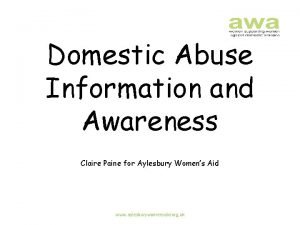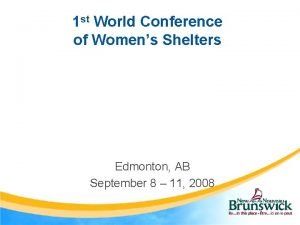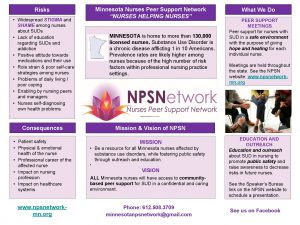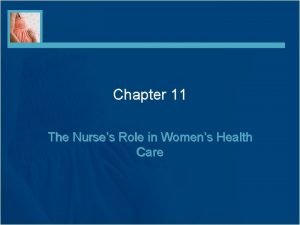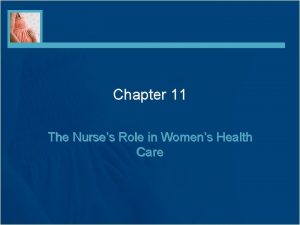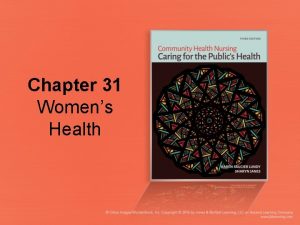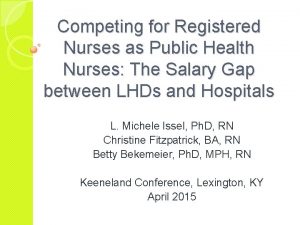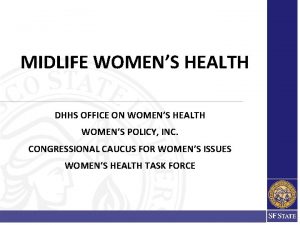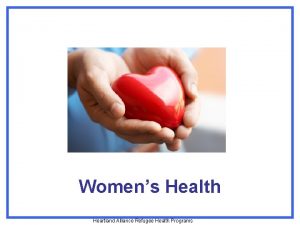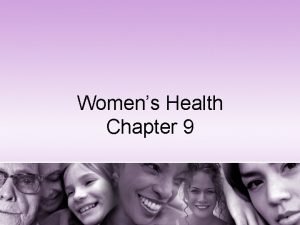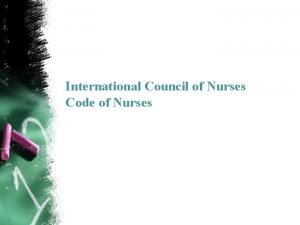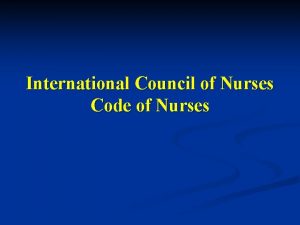Chapter 11 The Nurses Role in Womens Health
























































- Slides: 56

Chapter 11 The Nurse’s Role in Women’s Health Care Elsevier items and derived items © 2015, 2011, 2007, 2006 by Saunders, an imprint of Elsevier Inc.

Lesson 11. 1 Objectives 2. Explain aspects of preventive health care for women. 3. Describe each menstrual disorder and its care. 4. Explain each gynecological infection in terms of cause, transmission, treatment, and care. Elsevier items and derived items © 2015, 2011, 2007, 2006 by Saunders, an imprint of Elsevier Inc. 2

Goals of Healthy People 2020 (p. 250) Increase the number of women over 40 who have mammograms to help curb the rise in breast cancer. Increase the number of women over 21 who have Pap tests to reduce the number of deaths from cervical cancer. Reduce occurrence of vertebral/hip fractures in older women with osteoporosis Reduce occurrence of STIs and PID. Elsevier items and derived items © 2015, 2011, 2007, 2006 by Saunders, an imprint of Elsevier Inc. 3

Preventive Health Care for Women (pp. 250 -251) Teaching how to perform breast selfexamination (BSE) Mammography Vulvar self-examination (VSE) Pelvic examination Elsevier items and derived items © 2015, 2011, 2007, 2006 by Saunders, an imprint of Elsevier Inc. 4

Breast Care (p. 251) Three approaches for early detection of breast cancer: Ø Ø Ø Monthly BSE Annual professional breast examination Mammography, as appropriate Elsevier items and derived items © 2015, 2011, 2007, 2006 by Saunders, an imprint of Elsevier Inc. 5

Vulvar Self-Examination (p. 251) Should begin at 18 years of age Perform monthly to identify lesions or masses Use a hand mirror to inspect systematically, palpate vulva and mons pubis If any abnormalities found, report them to health care provider Elsevier items and derived items © 2015, 2011, 2007, 2006 by Saunders, an imprint of Elsevier Inc. 6

Pelvic Examination (pp. 251 -253) Pap test start at 21 years or older, regardless of sexual activity. Every 3 years for women age 21 -29 Every 5 years for women age 30 -65 No screening necessary for women over the age of 65 with negative screening for past 10 years. Elsevier items and derived items © 2015, 2011, 2007, 2006 by Saunders, an imprint of Elsevier Inc. 7

Menstrual Disorders (p. 253) Common nursing roles include Ø Ø Ø Explaining any recommended treatments Caring for the woman before and after procedures Provide emotional support Elsevier items and derived items © 2015, 2011, 2007, 2006 by Saunders, an imprint of Elsevier Inc. 8

Amenorrhea (p. 253) The absence of menstruation Normal before menarche, during pregnancy, and after menopause Ø Ø Primary Secondary Treatment depends on cause identified Elsevier items and derived items © 2015, 2011, 2007, 2006 by Saunders, an imprint of Elsevier Inc. 9

Abnormal Uterine Bleeding (p. 253) Three types Ø Ø Ø Too frequent Too long in duration Excessive in amount Common causes Ø Ø Ø Pregnancy complications Lesions of the vagina, cervix, or uterus Breakthrough bleeding when on contraceptives Endocrine disorders Failure to ovulate Elsevier items and derived items © 2015, 2011, 2007, 2006 by Saunders, an imprint of Elsevier Inc. 10

Menstrual Cycle Pain (pp. 253 -254) Mittelschmerz is pain that many women experience around ovulation, near the middle of their menstrual cycle Dysmenorrhea, painful menses or cramps Ø Ø Primary—no evidence of pelvic abnormality Secondary—a pathologic condition is identified Vasopressins and prostaglandins from the endometrium contribute Potent stimulants of painful uterine contractions Elsevier items and derived items © 2015, 2011, 2007, 2006 by Saunders, an imprint of Elsevier Inc. 11

Endometriosis (p. 254) The presence of tissue that resembles the endometrium outside of the uterus Ø Can cause pain, pressure, and inflammation • More constant than spasmodic Ø Can cause dyspareunia (painful sexual intercourse) Elsevier items and derived items © 2015, 2011, 2007, 2006 by Saunders, an imprint of Elsevier Inc. 12

Premenstrual Dysphoric Disorder (PMDD) (p. 254) Formerly called premenstrual syndrome Associated with abnormal serotonin response to normal changes in estrogen levels Symptoms occur between ovulation and the onset of menstruation Are not present the week after menstruation has occurred Elsevier items and derived items © 2015, 2011, 2007, 2006 by Saunders, an imprint of Elsevier Inc. 13

Symptoms/Diagnosis of PMDD (p. 254) Five or more must occur regularly Ø Ø Ø Depressed mood Anxiety, tension, feeling “on edge” Increased sensitivity to rejection Irritability Decreased interest in usual activities Difficulty in concentrating Lethargy Change in appetite Change in sleep habits Feeling overwhelmed Physical symptoms; i. e. , breast tenderness, bloating, weight gain, headaches Elsevier items and derived items © 2015, 2011, 2007, 2006 by Saunders, an imprint of Elsevier Inc. 14

Factors That Change Normal Flora of the Vagina (p. 255) Antibiotics—encourage yeast overgrowth Douching—changes p. H within the vagina Sexual intercourse—raises p. H to 7 or higher for up to 8 hours after coitus Uncontrolled diabetes mellitus—high sugars promote growth of microorganisms Elsevier items and derived items © 2015, 2011, 2007, 2006 by Saunders, an imprint of Elsevier Inc. 15

Preventing Vaginal Infections (p. 255) Teach the woman to Ø Ø Ø Ø Wear cotton underwear Avoid tight nylon or Spandex pants Wipe front to back after toileting Frequent hand hygiene High-fiber, low-fat diet Exercise Avoid douching or using internal feminine hygiene products Elsevier items and derived items © 2015, 2011, 2007, 2006 by Saunders, an imprint of Elsevier Inc. 16

Gynecological Infections (p. 255) Nurse’s role Ø Ø Ø Educating women concerning vaginal health Prevention of STIs Identifying high-risk behaviors • Safe sex practices • Reducing number of sexual partners • Avoiding exchange of bodily fluids Ø Provide nonjudgmental, sensitive counseling Elsevier items and derived items © 2015, 2011, 2007, 2006 by Saunders, an imprint of Elsevier Inc. 17

Toxic Shock Syndrome (TSS) (pp. 255 -256) Usually caused by strains of Staphylococcus aureus toxins that can produce shock, coagulation defects, and tissue damage if they enter the bloodstream Ø Usually results from the trapping of bacteria in the reproductive tract for a prolonged period of time Use of high-absorbency tampons Use of a diaphragm or cervical cap for contraception Elsevier items and derived items © 2015, 2011, 2007, 2006 by Saunders, an imprint of Elsevier Inc. 18

Signs and Symptoms of TSS (pp. 255 -256) Sudden spiking fever Flulike symptoms Hypotension Generalized rash that resembles a sunburn Skin peeling from palms of hands and soles of feet after 1 to 2 weeks of the illness Elsevier items and derived items © 2015, 2011, 2007, 2006 by Saunders, an imprint of Elsevier Inc. 19

Prevention of TSS (pp. 255 -256) Hand hygiene Change tampons at least every 4 hours Do not use super-absorbent tampons Use peri pads rather than tampons when sleeping Do not use diaphragm or cervical cap during the menstrual period Remove diaphragm or cervical cap as recommended by the health care provider Elsevier items and derived items © 2015, 2011, 2007, 2006 by Saunders, an imprint of Elsevier Inc. 20

Sexually Transmitted Infections (pp. 256 -260) Infections that can be spread by sexual contact, although some have other modes of transmission Elsevier items and derived items © 2015, 2011, 2007, 2006 by Saunders, an imprint of Elsevier Inc. 21

Types of Sexually Transmitted Infections (pp. 256 -260) Fungal or bacterial Ø Ø Ø Ø Candidiasis Trichomoniasis Bacterial vaginosis Chlamydia trachomatis Gonorrhea/GC Syphilis PID Viral Ø Ø Ø Herpes simplex virus II (HSV-II) Condylomata acuminata Human papillomavirus (HPV) Hepatitis B HIV/AIDS Elsevier items and derived items © 2015, 2011, 2007, 2006 by Saunders, an imprint of Elsevier Inc. 22

Lesson 11. 2 Objectives 5. Describe the various methods of birth control, including side effects and contraindications of each method. 6. Describe how to use natural family planning methods for contraception or infertility management. 7. Describe possible causes and treatment of infertility. Elsevier items and derived items © 2015, 2011, 2007, 2006 by Saunders, an imprint of Elsevier Inc. 23

Family Planning and the Nurse’s Role (p. 260) Answering general questions concerning contraceptive methods Explaining different methods available Ø Ø Advantages Disadvantages Teaching correct use of contraceptive methods Elsevier items and derived items © 2015, 2011, 2007, 2006 by Saunders, an imprint of Elsevier Inc. 24

Factors that Influence Choice of Contraceptive Methods (p. 260) Age Health status Religion or culture Impact of unplanned pregnancy on the woman or family Desire for future children Frequency of sexual intercourse Convenience and degree of spontaneity desired Expense Number of sexual partners Elsevier items and derived items © 2015, 2011, 2007, 2006 by Saunders, an imprint of Elsevier Inc. 25

Natural Family Planning (p. 260) Also called fertility awareness Involves learning to identify the signs and symptoms associated with ovulation Acceptable to most religions Requires no administration of medication or use of devices Natural family planning is reversible Failure rate of 20% Elsevier items and derived items © 2015, 2011, 2007, 2006 by Saunders, an imprint of Elsevier Inc. 26

Types of Natural Family Planning (p. 261) Basal body temperature Cervical mucus Calendar or rhythm method Marquette method Elsevier items and derived items © 2015, 2011, 2007, 2006 by Saunders, an imprint of Elsevier Inc. 27

Temporary Contraception Hormonal Contraception (pp. 262 -264) A form of temporary birth control Prevents ovulation Makes cervical mucus thick and resistant to sperm penetration Makes uterine endometrium less hospitable if fertilized ovum arrives Elsevier items and derived items © 2015, 2011, 2007, 2006 by Saunders, an imprint of Elsevier Inc. 28

Temporary Contraception (cont. ) Hormonal Contraception (pp. 262 -264) Types Ø Ø Ø Ø Monthly Extended Delayed menstruation Implants Injections Transdermal patch Vaginal ring IUD Does not protect either partner from STIs, including HIV Elsevier items and derived items © 2015, 2011, 2007, 2006 by Saunders, an imprint of Elsevier Inc. 29

ACHES—Warning Signs to Report when Taking Oral Contraceptives (p. 263) Abdominal pain (severe) Chest pain, dyspnea, bloody sputum Headache (severe), weakness, or numbness of extremities Eye problems Severe leg pain or swelling, speech disturbance Elsevier items and derived items © 2015, 2011, 2007, 2006 by Saunders, an imprint of Elsevier Inc. 30

Medications that Decrease Oral Contraceptive Effectiveness (p. 263) Some antimicrobials, such as ampicillin and tetracycline Anticonvulsants Rifampin Barbiturates Elsevier items and derived items © 2015, 2011, 2007, 2006 by Saunders, an imprint of Elsevier Inc. 31

Barrier Contraceptives (pp. 264 -267) Diaphragm Cervical cap Male condom Female condom Spermicides Elsevier items and derived items © 2015, 2011, 2007, 2006 by Saunders, an imprint of Elsevier Inc. 32

Question 1 A 16 -year-old female comes to the family planning clinic for contraceptive advice. She says she wants to take “the pill. ” Her vital signs are within normal limits. What assessment information is priority? 1) 2) 3) 4) Exercise history Nutritional information Smoking history Stress assessment Elsevier items and derived items © 2015, 2011, 2007, 2006 by Saunders, an imprint of Elsevier Inc. 33

Emergency Contraception (p. 267) The “morning after pill” is a method of preventing pregnancy Must be taken no later than 72 hours after unprotected sexual intercourse and may need to be repeated 12 hours after the first pill Ø Depends on the type of pill purchased Elsevier items and derived items © 2015, 2011, 2007, 2006 by Saunders, an imprint of Elsevier Inc. 34

Unreliable Contraceptive Methods (p. 268) Withdrawal Douching Breastfeeding Ø Providing 10 breastfeedings in a 24 -hour period can inhibit ovulation due to increased prolactin secretion Elsevier items and derived items © 2015, 2011, 2007, 2006 by Saunders, an imprint of Elsevier Inc. 35

Permanent Contraception (pp. 268 -269) Male sterilization Ø Vasectomy Female sterilization Ø Ø Tubal ligation Hysteroscopic sterilization Elsevier items and derived items © 2015, 2011, 2007, 2006 by Saunders, an imprint of Elsevier Inc. 36

Infertility Care (p. 269) Infertility occurs when a couple who has regular unprotected sexual intercourse for 1 year cannot conceive Elsevier items and derived items © 2015, 2011, 2007, 2006 by Saunders, an imprint of Elsevier Inc. 37

Social and Psychological Implications Related to Infertility (p. 269) Assumption of fertility Psychological reactions Ø Ø Guilt Isolation Depression Stress on the relationship Cultural and religious considerations Elsevier items and derived items © 2015, 2011, 2007, 2006 by Saunders, an imprint of Elsevier Inc. 38

Factors Affecting Fertility (pp. 270 -271) Male Ø Abnormalities of • • Sperm Erections Ejaculation Seminal fluid Female Ø Ø Disorders of ovulation Abnormalities of • Fallopian tubes • Uterus, cervix, or ovaries • Hormones Elsevier items and derived items © 2015, 2011, 2007, 2006 by Saunders, an imprint of Elsevier Inc. 39

Factors Affecting Fertility (cont. ) (p. 271) Coital frequency Age Cigarette smoking Exercise, diet, and weight Emotional factors Medical problems Drugs and chemicals Elsevier items and derived items © 2015, 2011, 2007, 2006 by Saunders, an imprint of Elsevier Inc. 40

Evaluation of Infertility (pp. 271 -272) Male Ø Ø Semen analysis Endocrine test Ultrasonography Testicular biopsy Female Ø Ø Ø Ultrasonography Postcoital test Endocrine test Hysterosalpingogram Endometrial biopsy Hysteroscopy Elsevier items and derived items © 2015, 2011, 2007, 2006 by Saunders, an imprint of Elsevier Inc. 41

Therapy for Infertility (p. 272) Medications Surgical procedures Therapeutic insemination Surrogate parenting Advanced reproductive techniques Ø Ø IVF GIFT TET ZIFT Microsurgical techniques Elsevier items and derived items © 2015, 2011, 2007, 2006 by Saunders, an imprint of Elsevier Inc. 42

Infertility Therapy (pp. 273 -274) Outcomes Ø Ø Ø Legal and ethical issues Ø Ø Achievement of pregnancy to viability Unsuccessful Pregnancy loss after treatment Surrogates Parental rights Cloning Sale of frozen embryos Nursing care related to infertility treatment Ø Ø Supporting the couple Teaching coping skills Elsevier items and derived items © 2015, 2011, 2007, 2006 by Saunders, an imprint of Elsevier Inc. 43

Lesson 11. 3 Objectives 8. Explain the changes that occur during the perimenopausal period and after menopause. 9. Explain the medical and nursing care of women who are nearing or have completed menopause. 10. Discuss the medical and nursing care of women with pelvic floor dysfunction or problems related to benign growths in the reproductive tract. 11. Describe the nursing care and treatment of a woman with leiomyomas. Elsevier items and derived items © 2015, 2011, 2007, 2006 by Saunders, an imprint of Elsevier Inc. 44

Menopause (p. 274) Cessation of menstrual periods for a 12 month period because of decreased estrogen production Climacteric—change of life—is also known as the perimenopausal period (which is 2 to 8 years before menstruation ceases) Pregnancy can still occur during the climacteric Elsevier items and derived items © 2015, 2011, 2007, 2006 by Saunders, an imprint of Elsevier Inc. 45

Physical Changes in Menopause (p. 274) Usually caused by a decrease in estrogen Changes in the menstrual cycle Vasomotor instability, known as hot flashes Decreased elasticity and moisture of the vagina Dyspareunia Some may notice change in libido (sexual desire) Breast atrophy Loss of protective effect of estrogen on the cardiovascular and skeletal systems Elsevier items and derived items © 2015, 2011, 2007, 2006 by Saunders, an imprint of Elsevier Inc. 46

Psychological and Cultural Variations (p. 274) Can threaten the woman’s feelings of health and self-worth Liberation from monthly periods Ends fear of unwanted pregnancy Elsevier items and derived items © 2015, 2011, 2007, 2006 by Saunders, an imprint of Elsevier Inc. 47

Treatment Options (pp. 274 -275) Exercise Increase in calcium, magnesium, and highfiber diet Hormone replacement therapy (HRT), which may increase risk of heart attack and stroke, is based on the individual patient and discussions with her health care provider Complementary and alternative therapies Prevention of osteoporosis Elsevier items and derived items © 2015, 2011, 2007, 2006 by Saunders, an imprint of Elsevier Inc. 48

Question 2 Hormone replacement therapy increases a woman’s risk of breast cancer. 1) True 2) False Elsevier items and derived items © 2015, 2011, 2007, 2006 by Saunders, an imprint of Elsevier Inc. 49

Nursing Care of the Menopausal Woman (pp. 275 -277) Determine woman’s understanding of risk/benefits of HRT Ø Ø Ø Teach signs and symptoms to report; i. e. , vaginal bleeding that recurs after cessation of menses, vaginal irritation, signs of UTI Teach woman how to take prescribed medications correctly and to report specific side effects Teach value of weight-bearing exercises Elsevier items and derived items © 2015, 2011, 2007, 2006 by Saunders, an imprint of Elsevier Inc. 50

Pelvic Floor Dysfunction (pp. 277 -278) Occurs when the muscles, ligaments, and fascia that support the pelvic organs are damaged or weakened Can result in Ø Vaginal wall prolapse • Cystocele • Rectocele Ø Uterine prolapse • Kegel exercises • Treated with surgery or pessary Ø Urinary incontinence Elsevier items and derived items © 2015, 2011, 2007, 2006 by Saunders, an imprint of Elsevier Inc. 51

Nursing Care for Pelvic Floor Dysfunction (p. 278) Instructing the woman on Ø Ø The use of exercises Diet Prevention of constipation Adequate fluid intake Elsevier items and derived items © 2015, 2011, 2007, 2006 by Saunders, an imprint of Elsevier Inc. 52

Other Female Reproductive Tract Disorders (p. 278) Uterine fibroids, also known as leiomyomas Ø Ø Ø Benign growth of uterine muscle cells Grow under influence of estrogen Result in irregular bleeding, pelvic pressure, dysmenorrhea, menorrhagia Elsevier items and derived items © 2015, 2011, 2007, 2006 by Saunders, an imprint of Elsevier Inc. 53

Treatment of Fibroids (p. 278) If asymptomatic, observed and periodically reevaluated by health care provider Hormones Surgical interventions Ø Ø Myomectomy Myolysis Embolization Hysterectomy Elsevier items and derived items © 2015, 2011, 2007, 2006 by Saunders, an imprint of Elsevier Inc. 54

Ovarian Cysts (p. 278) Follicular ovarian cysts develop if follicle fails to rupture and release its ovum during the menstrual cycle Lutein cyst occurs after ovulation, the corpus luteum fails to regress Ovarian cyst that ruptures or becomes twisted, cutting off blood supply, causes pelvic pain and tenderness Diagnosed by transvaginal ultrasound Laparotomy is the treatment of choice Elsevier items and derived items © 2015, 2011, 2007, 2006 by Saunders, an imprint of Elsevier Inc. 55

Cultural Aspects of Pain Control (p. 278) Pain is the fifth vital sign Culture can influence the expression of pain Ethnicity can affect drug metabolism Diet can affect drug absorption CAM can affect action of prescribed drugs Pain clinics are available Some cultural groups will not report embarrassing side effects of drugs Nurses must understand the cultural influences on pain expression Elsevier items and derived items © 2015, 2011, 2007, 2006 by Saunders, an imprint of Elsevier Inc. 56
 What are the roles of community health nurse
What are the roles of community health nurse Role of nurse in group therapy
Role of nurse in group therapy Occupational health nurse roles and responsibilities
Occupational health nurse roles and responsibilities Needs of adolescence
Needs of adolescence Womens rights
Womens rights Late night womens hour
Late night womens hour Aylesbury womens aid
Aylesbury womens aid Womens right
Womens right Differences between men's and women's soccer
Differences between men's and women's soccer Womens college kumbakonam
Womens college kumbakonam Womens college kumbakonam
Womens college kumbakonam Womens right
Womens right Womens shelter edmonton
Womens shelter edmonton Women's rights
Women's rights Female anus real
Female anus real Womens history month door
Womens history month door Womens community shelters
Womens community shelters Ballybeen womens centre
Ballybeen womens centre Scarborough womens centre
Scarborough womens centre Mens lacrosse helmet
Mens lacrosse helmet Bristol womens voice
Bristol womens voice Azure web role worker role example
Azure web role worker role example Krappmann role taking
Krappmann role taking Statuses and their related roles determine the structure
Statuses and their related roles determine the structure Chapter 3 health wellness and health disparities
Chapter 3 health wellness and health disparities Chapter 1 understanding health and wellness lesson 2
Chapter 1 understanding health and wellness lesson 2 Chapter 1 health and wellness fundamentals
Chapter 1 health and wellness fundamentals Hình ảnh bộ gõ cơ thể búng tay
Hình ảnh bộ gõ cơ thể búng tay Bổ thể
Bổ thể Tỉ lệ cơ thể trẻ em
Tỉ lệ cơ thể trẻ em Voi kéo gỗ như thế nào
Voi kéo gỗ như thế nào Tư thế worm breton
Tư thế worm breton Alleluia hat len nguoi oi
Alleluia hat len nguoi oi Môn thể thao bắt đầu bằng chữ đua
Môn thể thao bắt đầu bằng chữ đua Thế nào là hệ số cao nhất
Thế nào là hệ số cao nhất Các châu lục và đại dương trên thế giới
Các châu lục và đại dương trên thế giới Cong thức tính động năng
Cong thức tính động năng Trời xanh đây là của chúng ta thể thơ
Trời xanh đây là của chúng ta thể thơ Mật thư tọa độ 5x5
Mật thư tọa độ 5x5 Làm thế nào để 102-1=99
Làm thế nào để 102-1=99 Phản ứng thế ankan
Phản ứng thế ankan Các châu lục và đại dương trên thế giới
Các châu lục và đại dương trên thế giới Thơ thất ngôn tứ tuyệt đường luật
Thơ thất ngôn tứ tuyệt đường luật Quá trình desamine hóa có thể tạo ra
Quá trình desamine hóa có thể tạo ra Một số thể thơ truyền thống
Một số thể thơ truyền thống Bàn tay mà dây bẩn
Bàn tay mà dây bẩn Vẽ hình chiếu vuông góc của vật thể sau
Vẽ hình chiếu vuông góc của vật thể sau Biện pháp chống mỏi cơ
Biện pháp chống mỏi cơ đặc điểm cơ thể của người tối cổ
đặc điểm cơ thể của người tối cổ Ví dụ giọng cùng tên
Ví dụ giọng cùng tên Vẽ hình chiếu đứng bằng cạnh của vật thể
Vẽ hình chiếu đứng bằng cạnh của vật thể Vẽ hình chiếu vuông góc của vật thể sau
Vẽ hình chiếu vuông góc của vật thể sau Thẻ vin
Thẻ vin đại từ thay thế
đại từ thay thế điện thế nghỉ
điện thế nghỉ Tư thế ngồi viết
Tư thế ngồi viết
